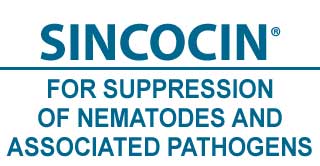SINCOCIN promotes healthier roots by controlling harmful nematodes
SINCOCIN increases the populations of beneficial microorganisms which can significantly improve soil nutrient supply to roots. For instance, key plant macro nutrients such as nitrogen, sulphur and phosphorus all require microorganisms in the root zone to make them more available to the plant. Many agronomic practices, however, suppress these organisms and hence limit the nutrient supply to the roots, even in situations where adequate fertilizer has been applied. Such is the dependency of the root and soil ecosystem on soil micro-organisms. Root building phosphorus, in particular, is dependent on microbes for its release into the soil, especially in low or high pH soils.
The use of SINCOCIN in plant fertility programs has led in many crop systems to large improvements in the efficiency of utilization of nutrients such as nitrogen and hence a concomitant reduction in application rate. The use of SINCOCIN in plant fertility programs has led in many crop systems to large improvements in the efficiency of utilization of nutrients such as nitrogen and phosphorus. Another benefit of increased microorganism activity is improved soil structure.
When needed, SINCOCIN and conventional nematicides are an effective combination
In soils with high nematode populations, or where plant infection has already occurred, a sequential combination of conventional nematicides and SINCOCIN is recommended. Start treatment with a single application of the pesticide to reduce the nematode population, then follow up with ongoing applications of SINCOCIN to keep the population low and under control. This combination method reduces the hazard of residual toxicity as well as the possibility of the nematodes developing gradual resistance to the pesticide and re-infesting the plant. SINCOCIN is the perfect partner in IPM programs.
SINCOCIN is economical and easy to use
The application rate of SINCOCIN liquid concentrate (diluted with water) makes the product very economical to use. Rates vary from 2 oz per 1,000 sq. ft., for turf and ornamentals, to 26 oz an acre for orchards and food crops. Recommended application for orchards and food crops is once during initial leaf flush and every 45 to 60 days after, during active growth. For turf and ornamentals, once every 30 to 45 days with a maximum of 10 applications per year. As for method of application, SINCOCIN can be applied via boom, fan jet, hand-carried, or backpack spray equipment.

